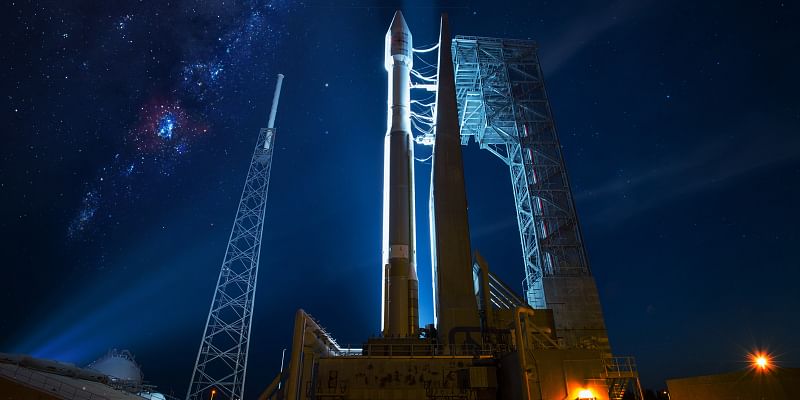Spacetech has become a buzzword in the Indian startup ecosystem due to the new spacetech reforms, aimed at including private players and boosting the opportunity for commercial space missions.
As the spacetech startup ecosystem is readying itself to successfully launch its own commercial space missions, investor interest in the sector is also rising. However, the question remains, how will the increased number of commercial space missions help India?
Pawan Kumar Chandana, Co-founder and CEO of Skyroot Aerospace, says governments across the world have mainly led the space mission since the 1960s. However, government efforts are many times dependent on national space budgets; private sector participation will ensure the scaling up of the sector.
Image Credit: Shutterstock
“Private sector participation in commercial space activities has the potential to catalyse new investments at scale, build new space-based applications, and reduce costs by making value chains more efficient and achieving scale,” he says.
He explains that commercial space missions can help create new markets across multiple sectors that need communication or earth observation facilities such as broadband internet, agriculture, IoT, education, transportation, urban planning, military surveillance, telecommunication, banking, media and entertainment, and scientific research, among others.
Applications of space services
The Indian spacetech sector has always been headed by the Indian Space Research Organisation (ISRO), which was launched by Dr Vikram Sarabhai on August 15, 1969. The sector has now, however, opened up to the private sector to cater to the increased demand for space-based applications and services.
Rahul Rawat, COO of SID, IISc-incubated spacetech startup Digantara, says: “We are widely dependent on services derived from the space sector such as communication, navigation, imaging, broadcasting, and whatnot. Commercial space missions are an enabler to these services.”
Several space tech startups are building their own satellites and launch vehicles to contribute to India’s commercial space missions. For example, the deployment of small satellites can help in enabling IoT networks, ensuring communication and internet reach, and for earth observation.
Speaking to YS, Awais Ahmed, Co-founder and CEO of Pixxel, explains that hyperspectral data from Pixxel’s earth observation satellites can help make the agricultural process more efficient by detecting pests infestations and crop diseases in time. It can also help protect forest health by monitoring forest biodiversity and deforestation, among other applications.
“Be it different kinds of earth observation data, communication satellites, commercial launch providers, competition and choices lead to a proliferation of use cases and drives costs down. Commercial launch providers can keep the costs of launching these imaging satellites low, which translates to lower costs of imagery itself. This will lead to widespread adoption of data,” he adds.
India’s spacetech sector has opened up to the private players at a time when a lot of industrial infrastructure and ecosystems are already in place.
Awais believes that the space effort can be divided between the public and private sectors. He says government-funded space organisations such as ISRO can completely focus on research and enable cutting-edge technologies and leave commercial operations to private players.
Yashas Karanam, COO at Bellatrix Aerospace, says with the ecosystem being there, it might be easier for private players to take up complex space missions, further innovate, and spin-off technologies.
“Some of the most ambitious commercial space missions today focus on AI for in-orbit servicing, space-based data warehousing and encryption, solar power generation plants in space that can beam energy down to Earth, IoT satellites, drone quality 24X7 imaging from space, 6G communication, space planes for intercontinental travel (faster than aeroplanes), space tourism, etc. The benefits of all these technologies will translate to the improvement of the quality of life on Earth,” Yashas says.
Focusing on spacetech innovation
According to a report by PwC, the Indian space economy is valued at $7 billion and forms two percent of the global space economy. The opening up of the spacetech sector may propel India to grow further and expand its share in the global space market.
Srinath Ravichandran, Co-founder and CEO at AgniKul, says that before commercial space missions came into being, satellites were majorly used for national issues, but a strong commercial space sector will enable startups and founders to come up with new, innovative ways to use space services.
Apart from this, increasing commercial space missions will create more job opportunities in core engineering fields for the aerospace/spacetech sector.
Nitish Singh, Co-founder and CEO of Astrogate Labs, says a thriving commercial space sector will create more demand for indigenous satellite or satellite subsystems manufacturing and enable businesses to tap into the global space market, thus boosting exports.
“Existing businesses will also benefit from the market expansion of satellite and satellite-enabled services. I think we will see more synergies between the telecom and satellite communication providers down the line,” he adds.
Image Credit: Shutterstock
Fuelling interest among investors
Investors might have been wary of the ‘high-risk’ spacetech sector, but things have changed with investor interest picking up owing to the new reforms.
The year 2021 has already seen three big investment deals, with Agnikul and Skyroot each raising $11 million in May — the most raised in the sector to date, and Pixxel raising $7.3 million earlier in March.
Most recently, IIT Madras-incubated spacetech startup GalaxEye raised a pre-seed round led by Speciale Invest in June.
According to Vishesh Rajaram, Managing Partner at Speciale Invest, the declining cost of launch and “miniaturisation and standardisation of satellites” are the major factors behind the commercial space sector’s liftoff.
Research by Seraphim Capital, a global specialist investment group focused on the space industry, reveals that in the first quarter of 2021 alone, venture investment into the global space sector was $2.7 billion, compared with $1.6 billion in the same period last year.
Manish Singhal, Founding Partner, pi Ventures, believes that mapping companies, satellite imagery providers, and businesses providing communication solutions will do better in the future owing to the relaxation in geospatial data rules.
Image Credit: Shutterstock
Challenge of space debris
However, the increasing number of space missions brings a new challenge to the fore: space debris, also known as space junk. As more and more missions take place, the chances of satellites colliding with each other and leading to higher amounts of debris increase.
“Space missions are estimated to increase by tenfold in the next 10 years. At this rate, ensuring the sustainability of operations in space will be a major challenge. A huge problem of regulating space and space traffic management lies in front of us. This problem gets even worse in the highest used orbital belt of LEO,” Rahul says.
He explains that businesses will need to ensure the sustainability of satellites to avoid further collisions.
Awais says it will be important to regulate the sector to take care of the space debris problem.
“Regulating the sector will be something that will need to be done methodically to ensure frequency and orbit allocations, space debris mitigation, etc., are all taken care of,” Awais says.










